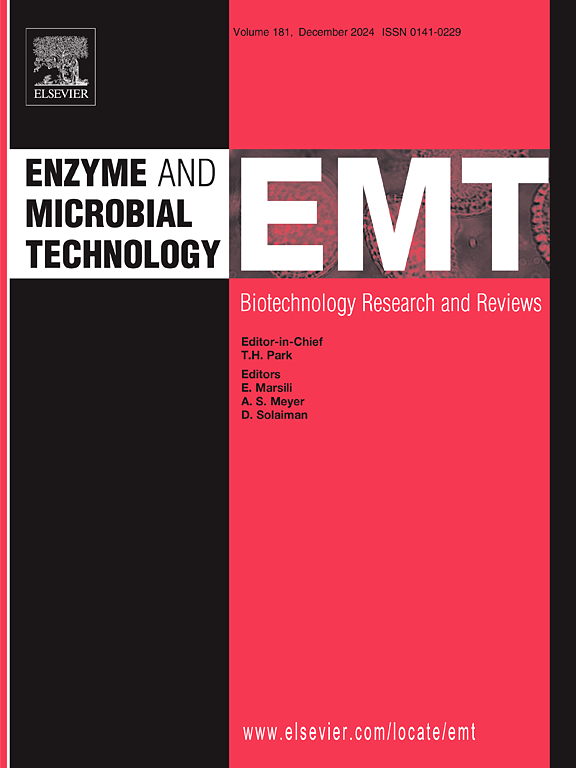Microbial production of adipic acid from 6-hydroxyhexanoic acid for biocatalytic upcycling of polycaprolactone
IF 3.4
3区 生物学
Q2 BIOTECHNOLOGY & APPLIED MICROBIOLOGY
引用次数: 0
Abstract
To valorize waste polycaprolactone (PCL), one of the most widely used biodegradable plastics, into a value-added chemical, we upcycled 6-hydroxyhexanoic acid (6-HHA), the sole monomer of PCL, into adipic acid (AA) using a microbial method. Recombinant Escherichia coli strains expressing chnD (6-HHA dehydrogenase) and chnE (6-oxohexanoic acid dehydrogenase) genes from three bacteria were constructed, and all these strains successfully produced AA from 6-HHA. Among these, the E. coli strain harboring ChnDE genes from Acinetobacter strain SE19 (E. coli [pKK-AcChn]) showed the highest AA-producing ability. To increase the AA production titer, we optimized the culture temperature of this strain in flask culture and performed fed-batch fermentation in a 5 L bioreactor. After the fed-batch fermentation, the AA production titer increased to 15.6 g/L. As 6-HHA is a monomer of PCL, our results provide the groundwork for the development of a biocatalytic upcycling method of PCL.
微生物利用 6-羟基己酸生产己二酸,用于聚己内酯的生物催化升 级再循环
聚己内酯(PCL)是最广泛使用的生物降解塑料之一,为了将废弃聚己内酯转化为高附加值化学品,我们采用微生物方法将聚己内酯的唯一单体 6-hydroxyhexanoic acid(6-HHA)升级循环为己二酸(AA)。我们构建了表达来自三种细菌的 chnD(6-HHA 脱氢酶)和 chnE(6-氧代己酸脱氢酶)基因的重组大肠杆菌菌株,所有这些菌株都成功地利用 6-HHA 生产出了 AA。其中,含有 SE19 阴沟杆菌 ChnDE 基因的大肠杆菌菌株(E. coli [pKK-AcChn])的 AA 产率最高。为了提高 AA 的生产滴度,我们优化了该菌株在烧瓶培养中的培养温度,并在 5 L 生物反应器中进行了喂料式批量发酵。批量喂养发酵后,AA 产量滴度增加到 15.6 克/升。由于 6-HHA 是 PCL 的单体,我们的研究结果为开发 PCL 的生物催化上循环方法奠定了基础。
本文章由计算机程序翻译,如有差异,请以英文原文为准。
求助全文
约1分钟内获得全文
求助全文
来源期刊

Enzyme and Microbial Technology
生物-生物工程与应用微生物
CiteScore
7.60
自引率
5.90%
发文量
142
审稿时长
38 days
期刊介绍:
Enzyme and Microbial Technology is an international, peer-reviewed journal publishing original research and reviews, of biotechnological significance and novelty, on basic and applied aspects of the science and technology of processes involving the use of enzymes, micro-organisms, animal cells and plant cells.
We especially encourage submissions on:
Biocatalysis and the use of Directed Evolution in Synthetic Biology and Biotechnology
Biotechnological Production of New Bioactive Molecules, Biomaterials, Biopharmaceuticals, and Biofuels
New Imaging Techniques and Biosensors, especially as applicable to Healthcare and Systems Biology
New Biotechnological Approaches in Genomics, Proteomics and Metabolomics
Metabolic Engineering, Biomolecular Engineering and Nanobiotechnology
Manuscripts which report isolation, purification, immobilization or utilization of organisms or enzymes which are already well-described in the literature are not suitable for publication in EMT, unless their primary purpose is to report significant new findings or approaches which are of broad biotechnological importance. Similarly, manuscripts which report optimization studies on well-established processes are inappropriate. EMT does not accept papers dealing with mathematical modeling unless they report significant, new experimental data.
 求助内容:
求助内容: 应助结果提醒方式:
应助结果提醒方式:


